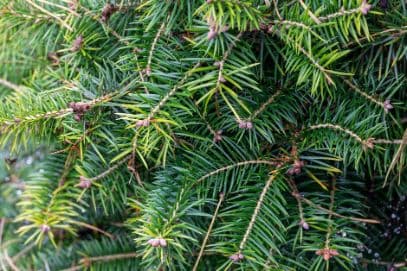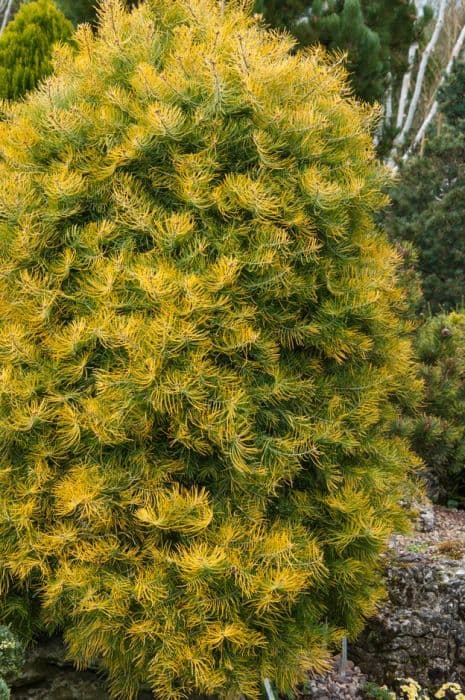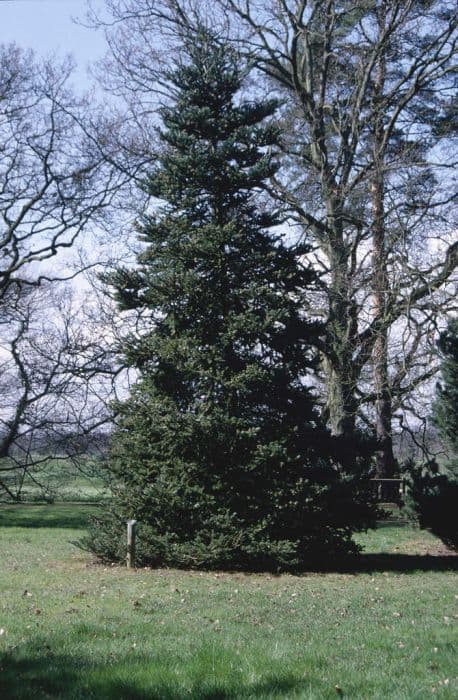Shore Pine Pinus contorta var. contorta

ABOUT
The plant known as lodgepole pine is characterized by its slender form and a trunk that is often contorted, hence the name. Its bark is thin and scaly, presenting a range of hues from yellowish-brown to darker shades, which can sometimes appear almost black. The needles of this pine come in pairs and can be recognized by their short length and twisted, rigid texture. They exhibit a deep green color, which contributes to the plant's overall evergreen appearance. The cones of the lodgepole pine are compact, with a distinct shape that tapers from a broad base to a sharper point at the tip—a bit like an egg’s silhouette. They remain closed for several years, and in some cases, only open to release their seeds in response to the intense heat of a wildfire. The branches tend to grow outwards from the trunk at right angles, giving the plant its unique and somewhat irregular appearance. These characteristics make the lodgepole pine a distinctive and easily recognizable species within its native habitats.
About this plant
 Names
NamesFamily
Pinaceae.
Synonyms
Shore Pine, Coast Pine, Contorta Pine, Twisted Pine, Beach Pine.
Common names
Pinus bolanderi, Pinus contorta var. bolanderi, Pinus contorta subsp. bolanderi, Pinus contorta var. typica.
 Toxicity
ToxicityTo humans
Lodgepole Pine is not commonly known to be toxic to humans. However, ingesting parts of any pine tree, including Lodgepole Pine, in large quantities could potentially cause irritation to the digestive tract, resulting in gastrointestinal discomfort or symptoms such as nausea or diarrhea. It is always recommended to use caution and avoid ingesting plant parts unless they are known to be safe and are prepared correctly.
To pets
Lodgepole Pine is generally not considered toxic to pets. Pets that ingest small amounts of pine needles or sap may experience mild gastrointestinal upset, such as vomiting or diarrhea, mainly due to the physical irritation caused by the needles or the oils in the sap. However, large quantities could potentially cause more serious issues, like blockages in the digestive tract, especially in smaller animals. Pet owners should monitor their pets to ensure they are not consuming large amounts of pine material and should consult a veterinarian if they observe any adverse health reactions.
 Characteristics
CharacteristicsLife cycle
Perennials
Foliage type
Evergreen
Color of leaves
Green
Height
30-50 feet (9-15 meters)
Spread
20-30 feet (6-9 meters)
Plant type
Tree
Hardiness zones
4-7
Native area
North America
Benefits
 General Benefits
General Benefits- Erosion control: Pinus contorta var. contorta, commonly known as shore pine, has a strong root system that helps stabilize soil and prevent erosion.
- Wildlife habitat: It provides habitat and shelter for various species of wildlife, both in its branches and the ecological system it supports.
- Economic value: Shore pine is used for timber and pulpwood, providing economic benefit through forestry industries.
- Recreational use: It’s commonly found in scenic landscapes and natural parks, offering aesthetic value and recreational opportunities for hikers and nature enthusiasts.
- Land rehabilitation: It’s often used in reforestation and land rehabilitation projects because it is a pioneer species that can grow in poor soil conditions and help prepare the ground for other species.
- Carbon sequestration: Like all trees, shore pine plays a role in carbon capture, helping to mitigate the effects of climate change by absorbing carbon dioxide from the atmosphere.
- Windbreak: Its dense form can act as a natural windbreak, providing protection for homes, crops, and ecosystems against strong winds.
- Biodiversity support: The shore pine supports biodiversity by providing a unique habitat that hosts a variety of plants and animals, thus contributing to ecosystem stability.
 Medical Properties
Medical PropertiesThis plant is not used for medical purposes.
 Air-purifying Qualities
Air-purifying QualitiesThis plant is not specifically known for air purifying qualities.
 Other Uses
Other Uses- Landscaping: Pinus contorta var. contorta, commonly known as lodgepole pine, is often used in landscaping for its adaptability and aesthetic appeal, especially suitable for creating woodland gardens.
- Windbreaks and Erosion Control: Due to its fast growth and resilience, lodgepole pine is planted to form windbreaks and to stabilize soil in areas prone to erosion.
- Christmas Trees: Some lodgepole pines are grown commercially and pruned to serve as Christmas trees due to their symmetrical shape and pleasing pine scent.
- Traditional Tools: Native American tribes have used the straight wood of the lodgepole pine to make tools, including crafting frames for tipis.
- Animal Habitats: These trees provide important habitats for various wildlife species, offering shelter and nesting sites for birds and small mammals.
- Edible Seeds: Lodgepole pine's seeds are edible and can be a source of food when other resources are scarce, although they are small and labor-intensive to harvest.
- Environmental Education: Lodgepole pines are used in educational settings to teach about forest ecology and the role of fire in pine forest regeneration.
- Cultural Significance: The trees have cultural importance in certain regions, being part of many local myths, legends, and traditions.
- Woodworking Projects: The wood of lodgepole pine is often used for woodworking projects and can be made into furniture, crafts, and rustic decor.
- Coastal Defense: In some coastal regions, lodgepole pine is utilized in reforestation projects to help reduce the impact of sea winds and salt spray on inland areas.
Interesting Facts
 Feng Shui
Feng ShuiThe Lodgepole Pine is not used in Feng Shui practice.
 Zodiac Sign Compitability
Zodiac Sign CompitabilityThe Lodgepole Pine is not used in astrology practice.
 Plant Symbolism
Plant Symbolism- Resilience: Pinus contorta var. contorta, commonly known as the Shore Pine, often grows in tough, challenging environments, symbolizing the ability to withstand adversity and recover from harsh conditions.
- Adaptability: The Shore Pine's twisting and contorted growth habit, which gives it its name, represents the capacity to adapt to one's surroundings and thrive even when the conditions are not ideal.
- Longevity: As a species of pine, the Shore Pine can live for many years, making it a symbol of longevity and endurance through time.
- Steadfastness: The Shore Pine’s solid and stable presence in coastal ecosystems reflects qualities of steadfastness and reliability.
 Water
WaterThe Lodgepole Pine, commonly known as the Pinus contorta var. contorta, requires moderate watering. Newly planted trees need water once or twice a week, allowing soil to dry slightly between watering sessions. Established trees are drought-tolerant and typically require watering every two to three weeks during dry periods. When watering, give the tree a deep soak by slowly watering around the base, using approximately 5 gallons for smaller trees and up to 15 gallons for larger, mature trees each time you water.
 Light
LightThe Lodgepole Pine thrives in full sun conditions and should be planted in a spot where it can receive at least 6 hours of unfiltered sunlight daily. The ideal spot for this pine is one that mimics its natural environment, with plenty of direct sunlight to encourage strong growth.
 Temperature
TemperatureThe Lodgepole Pine can withstand a wide range of temperatures, from a minimum of -30°F to a maximum of over 100°F. However, it grows best when the temperature is between 40°F and 70°F. It is well-adapted to cold climates and can handle frost without damage.
 Pruning
PruningPrune the Lodgepole Pine to remove dead or damaged branches, improve its shape, or to control its size. The best time for pruning is late winter to early spring, before new growth begins. Remove only the necessary branches and avoid heavy pruning, as pines do not readily form new buds on old wood. Generally, it can be pruned every 3 to 5 years.
 Cleaning
CleaningNot needed
 Soil
SoilLodgepole Pine thrives in a well-draining soil with a mix of sand, peat, and loamy components; it prefers slightly acidic to neutral pH levels around 5.5 to 7.0.
 Repotting
RepottingLodgepole Pines do not require frequent repotting; young trees may be repotted every 2-3 years, while mature trees can be repotted less often.
 Humidity & Misting
Humidity & MistingLodgepole Pine tolerates a wide range of humidity levels but prefers drier conditions typical of its natural forest habitats.
 Suitable locations
Suitable locationsIndoor
Place Lodgepole Pine in bright light, avoid overwatering.
Outdoor
Full sun, well-drained soil, protect from strong winds.
Hardiness zone
4-8 USDA.
 Life cycle
Life cycleThe common name for Pinus contorta var. contorta is the shore pine or lodgepole pine. The life cycle begins with seed germination, which requires a period of cold stratification to break dormancy. Once the seedling emerges, it enters a phase of establishment and growth, developing a taproot and beginning to form its characteristic pine needles. The juvenile phase can last several years as the tree grows in height and girth, forming its conical shape. Upon reaching maturity, the shore pine develops cones: male cones producing pollen and female cones developing into seed-bearing structures after pollination. Finally, as an adult tree, it continues to reproduce annually through cone production, with its life span potentially reaching several hundred years if conditions are favorable.
 Propogation
PropogationPropogation time
Spring to Summer
The lodgepole pine, scientifically known as Pinus contorta var. contorta, is typically propagated through the collection and planting of seeds, which is the most popular method. The best time to collect seeds is in late summer or early fall, when the cones are mature but not yet open. To propagate, gather the closed, mature cones and allow them to dry in a warm, well-ventilated area. As the cones dry, they will open to release the seeds. The seeds can then be extracted and sown into a well-drained seeding mix, covered lightly with soil, and kept moist until germination occurs. This process may take some time, as lodgepole pine seeds usually require a period of cold stratification to break dormancy; hence, planning to stratify the seeds in a refrigerator for about 1-3 months before sowing can be beneficial for increasing germination rates. After stratification, the seeds can be sown in the spring, ensuring that frost danger has passed for the best opportunity for successful seedling development.









